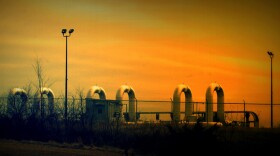The financial markets may be betting that the Keystone XL pipeline is a done deal.
The U.S. House and Senate have now both passed bills to force approval of the controversial pipeline. The southern leg of the project already delivers oil from Cushing, Oklahoma to the Texas Gulf Coast. But approval of the full build-out would link existing pipe to the Canadian border, allowing more crude from the tar sands of Canada to reach Texas refineries via Cushing.
President Obama has vowed to veto the bills, but one expert says the fate of the project may already be written in futures contracts for crude oil.
Futures contracts are agreements to buy and sell things at a fixed price to be delivered in the future. They give a window into what investors are betting the price of something will be years down the road. Benchmark oil prices are traded on the futures markets, and supply and demand are naturally a major factor in pricing.
Brent and WTI are the two major benchmark prices for crude oil. WTI is the benchmark price for crude in the U.S. It’s priced in Cushing, Oklahoma. Brent is the global price, and its delivery point is in the European North Sea.

"So one of the things we like to pride ourselves in finance is that markets are informative, they tell us something about the future," says Ehud Ronn, a Finance Professor at the University of Texas at Austin. "In this particular case, I'm looking at the spread in the futures prices between Brent and WTI."
Ronn has been studying graphs that show where markets are betting the price of U.S. oil and international crude will be relative to each other. The graphs show a clear divergence. Markets are betting U.S. crude will keep dropping in price relative to its European counterpart.
Why would crude in Cushing lose value? Maybe, Ronn speculates, because futures traders are betting there will be greater supply in the coming years. That greater supply could come from Canada.
"The market is possibly pricing in the probability that, in the near future, whether it be in greater than two years or less than two years, Keystone North will be approved and therefore start delivering oil to Cushing," says Ronn.
From there, much of it would make its way to refineries on the Texas Gulf Coast.
Environmental groups have made defeating the pipeline a major focus in recent years. The Canadian crude it would transport creates significantly more greenhouse gas pollution than traditional oil.





